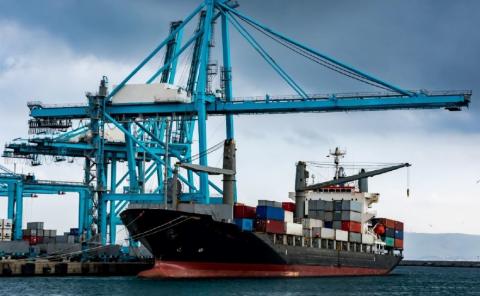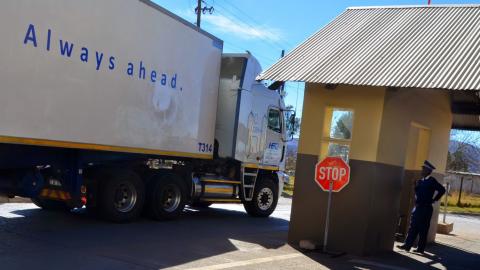Briefing note
The COVID-19 not only poses a severe global sanitarian threat, it also represents a supply and a demand shock - both aspects influencing international trade in goods and services. The following paragraphs point out the main challenges in trade and transport as an aftermath of the pandemic.
Spread prevention. Around 80% of global trade is transported by commercial shipping. Unfortunately, freight transport can contribute to the spread of the virus as it is not fully computerized. Both documents and goods continue to be subjected to physical checks for customs and other regulatory purposes. Staff in port structures, border-crossing points, and control terminals are exposed to the risk of pandemic by the nature of their work. Due to person-to-person transmission of the virus, drivers and other related workers crossing borders can be stopped for several weeks of quarantine. Against these risks, mitigation measures require automated sharing of trade and transport documents and data, based on international standards.
Intermediate-goods shortages. Lockdown policies in major producing and trading nations in the world i.e. China, Germany, Italy, Japan, Korea, and the US, have a strongly “contagious” effect on regions and countries commercially linked to them, damaging international supply chains and manufacturing. The psychological effects on government and corporate policy reactions may further affect supply-chains through a push for repatriation. The WTO forecast a fall in world trade in goods ranging from 12% to 32% in 2020, with double-digit declines in trade volumes in nearly all regions.
Increase in burdensome procedures. Border agencies face the challenge of speeding up clearance of imports and exports, including donations and relief consignments, while ensuring epidemic prevention and providing adequate compliance controls. Nonetheless, borders are closed or severely restricted for trucks, in some cases for trains, air transport, and inland and maritime shipping. Trade restrictions, especially on critical goods, are issued unilaterally regardless of the impact on the overall economic system or even the efficiency of the COVID-19 response and post-crisis recovery. Border measures such as health or permit checking of drivers create kilometres of queues and days of waiting time. Backlog of cargo at airports and seaports are the consequence of a sudden drop of demand, increased checking of documents at border, or other reasons.
Disruptions in the logistics industry. The pandemic poses such a serious threat to port communities and port authorities that they consider even closing partially or fully their operations. To mitigate the negative impact, it is crucial to keep ships moving, ports open and cross border trade flowing, while ensuring that border agencies can undertake all necessary controls, and all stakeholders can keep safe in the process. Policy action is called for, yet clearly the most effective action would be an internationally coordinated one, hence, the role of the United Nations.
Proliferation of legal actions. Unprecedented disruptions give rise to a plethora of commercial law implications affecting traders across the globe. These include the challenges from delays, performance failure, liability for breach of contract, frustration from the force majeure. The effects of the crisis may lead to extensive business losses and bankruptcies, which may overwhelm courts and the legal systems with broader implications for effective governance at national and international level, especially for the most vulnerable developing countries. Consequently, extensive legal implications give rise to a major increase in the need for competent legal advice to governments, industry association and traders
Poorly coordinated responses. The SARS crisis in East Asia in 2003 demonstrated that most control and facilitation measures bring more results if implemented at regional and, sometimes, global scale. Nonetheless, there has been little, if any, regional coordination on transport response to COVID-19. By the same token, although National Trade Facilitation Committees (NTFC) are the forum for coordination among government agencies and the private sector, many NTFCs unfortunately lack capacity, resources and common understanding of international trade procedures, let alone emergency action and coordination. Regional and national collaboration and coordination of cross-border trade are vital during emergency and crises situations to ensure the uninterrupted flow of trade and transport, in particular for landlocked and transit countries.
Against this background, governments need to urgently adopt common approaches to addressing these issues across the global network of supply chains to avoid widespread economic collapse. In the absence of urgent action in this regard, the post-pandemic economic recovery may be severely hampered, potentially worsening long term sustainable development prospects.
Last but not least – sustainability. The world is likely to emerge as a very different place from this crisis. So, let us work for it to be more suited to the goals of sustainable development, the circular economy and decreased damaging effects on the environment. The COVID-19 crisis is likely to throw back the achievements of decades-long effort to curb poverty. One example of desirable action is the need to reorganize international trade to factor in health issues that were a problem even before the COVID-19 crisis.
__________________________________________________________________________
The execution of the Project has resulted in numerous publications of Series and Project Documents that can be consulted in the link of publications of the Division of International Trade and Integration (https://www.cepal.org/en/publications/list/topics/8192).


